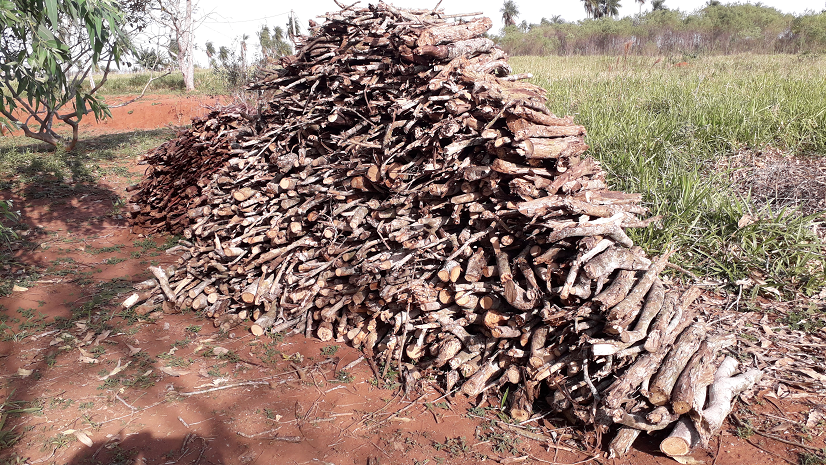On most days of the year firewood is my cooking fuel. There is also a small electric oven for those wet days when the woodpile is rain soaked. However most days the sun shines and the wood is dry.
Of course the cooking arrangements are a little more advanced than a camp fire on the ground. Rather than that the oven is a solid wood burning stove. A couple of rings for cooking and a smaller third for if ever I had the urge to boil a kettle whilst cooking lunch. Also an internal over. That though needs far too much heat built up over too much time to really be practical.
Fine control over the heat is obviously not possible. For pots on the rings that though is not essential. I long ago learnt to do without such things. Instead a look at the size of the fire gives clues as to how hot things are. The bigger the fire the greater the heat, nothing more complicated than that. In addition moving things further from the fire box reduces their temperature.
It may not be the most high tech way of preparing a meal, but it is one of the most enjoyable. Having a fire to watch and adjust makes the whole experience more involved. Furthermore it is generally agreed that things not cooked with firewood just don’t taste quite the same.
The biggest single problem apart from foolishly trying to light wet wood is damp wood. Here the problem is not getting the fire alight but keeping it that way. Also burning wood that is damp either though not having been allowed to dry long enough after cutting or that has dried properly after being rained on is that in order to burn water must be driven off.
This water mixing with the burning wood turns into thick smoke. For that reason my oven like many others is not inside my house. Instead it is located in an external kitchen, which on those occasions when it is filled with smoke does not also smoke out the house. Years of practice have resulted in the happening far less often than it used to.
Years of practice have also made lighting the fire far smoother and quicker. I have also learnt which days not to try and light the oven. Now on almost every occasion one match is all that is needed to light to oven and begin cooking.
Planning and preparation are the secrets to cooking with a wood stove. Spending a few minutes organizing the necessary firewood before hand and lunch can almost be left to cook itself.
I collect together all the wood I require before even trying to light the oven. Some thin twigs for kindling, two or three slightly thicker pieces to start the fire proper and then enough thicker wood to cook the meal. Added to all this a palm frond to start the fire and all the ingredients are to hand.
First I build a small tent with the kindling. Under this enough of a gap is left for the burning palm frond. The palm frond is lit with the match and held under the kindling to get the fire started. Once that starts to catch the slightly thicker sticks are placed on top. These will give enough heat to light the true fire wood. Also their weight stops the kindling from getting catapulted everywhere when I let go of the burning palm frond.
Once the wood is well alight the thicker sticks are added. One at a time so as to not smother the fire. Then in no time at all there is a roaring fire ready to be cooked on.
I have become quite a good judge of how much firewood the cooking will need. So very little goes to waste burning unnecessarily once the cooking is over. On the odd occasion when there is a little fire left that is used to boil a kettle for a cup of coffee.
My firewood really does grow on trees and costs me nothing. I have many trees and any dead branches or ones that are trimmed off are used as firewood. These are scattered around the garden or in my wood and when found are collected together to be turned into logs of a usable size.
Most of my firewood though comes from a row of eucalyptus trees. These grow more than five metres a year and so without an annual prune would soon become dangerously large. Apart from being quick growing there are a number of other ways in which eucalyptus is ideally suited to be sued as firewood.
Firstly the branches grow straight. So the wood is easy to use in an oven. Secondly when fresh the wood is soft and easily cut into logs of any desired length. Then as it dries the wood becomes very hard. As the hardness is a result of water being removed from the wood it then burns with a clean, hot flame. Additionally the oil left in the wood makes it easy to light.
The way in which I use just wood from my trees makes my cooking eco friendly and carbon neutral. The trees capture carbon as they grow. I release that carbon burning the firewood. Then the trees recapture it in their new growth. Harvesting from rather than felling trees maintains the balance.
A sustainable and self sufficient lifestyle.


Very good – but I don’t like the smoky wood burner stove!
It is all the more fun cooking with firewood. And with dry wood and enough practice no need for it to be smokey